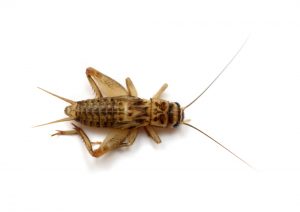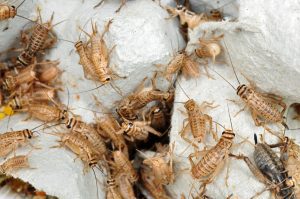HOUSE CRICKETS CAN BE PERMANENT INDOOR PESTS
By Chris Williams on October 29, 2018.
We sometimes get chirping crickets coming into our house in the fall. They’re usually large and dark in color but lately I’ve been seeing (and hearing) what seems to be a chirping cricket but it’s much lighter in color, almost a yellowish brown with stripes on its head. I’ve actually seen two of them in the enclosed breezeway between our house and garage. Are these something different?
L. V., Boston, MA
If you hadn’t mentioned the chirping, the best guess would have been camel crickets that also move indoors in the fall. However, they don’t chirp and they don’t look as cricket-like with their humped, wingless backs and very long hind legs (see Meet the Camel Cricket…or Spricket). You might be dealing with the less common house crickets instead. They match your description.
FALL WEATHER CAN BRING THEM INSIDE

House Cricket. Shutterstock.
House crickets (Acheta domesticus) are basically the same size and shape (although more slender) as the dark field crickets you mentioned (see House Crickets vs. Field Crickets). But, house crickets are straw-colored to light brown with three dark bands across the back of the head. They have wings that lay flat on their backs, and long antennae. Like field crickets and camel crickets, house crickets live mostly outside in mulch, wood or debris piles, or heavy vegetation, and near garbage cans or dumpsters.
In the cooler weather of fall, house crickets may move into sheds, garages, or houses seeking warmth and moisture. Interestingly, this is not the only way that house crickets become indoor pests. These easy-to-rear insects are sold live in pet stores as food for lizards, tarantulas, and other caged pets. Sometimes they escape before they can be eaten and…you know the rest of the story.
HOUSE CRICKETS ARE LIKE CHIRPING COCKROACHES!
The important difference between house crickets and the other two is that while field crickets and camel crickets don’t survive long in drier, indoor air, the more tolerant house crickets can survive and even reproduce indoors. That’s not a good thing for several reasons:
- they jump, climb, and fly to lights
- males chirp both day and night
- besides feeding on food crumbs, pet food, and dead insects, they can nibble on and cause damage to soiled clothing, linens, woolens, carpets, papers, leather, furs, wood, and rubber items.

House Crickets as reptile food. Shutterstock.
Indoors, house crickets have habits similar to cockroaches, hiding during the day and becoming active at night. They end up in basements or crawlspaces, behind baseboards, under stairwells, in crevices, and in warm, dark sites in kitchens, near fireplaces, in hot water heater closets, or behind appliances.
Since these crickets might become permanent residents of your home, give Colonial Pest a call now for a cricket intervention. We also provide a semi-annual preventative foundation treatment that will help keep crickets and other fall-invading pests out of your home. Ask us about our popular Preventative Maintenance Program for invading pests.
Cleaning up weeds, debris, stacked materials, and heavy mulch around your foundation will eliminate hiding places for crickets and other foundation pests (see How to Keep Outdoor Crickets From Getting Inside). Sealing around doors, windows, and other openings will also help keep crickets out.